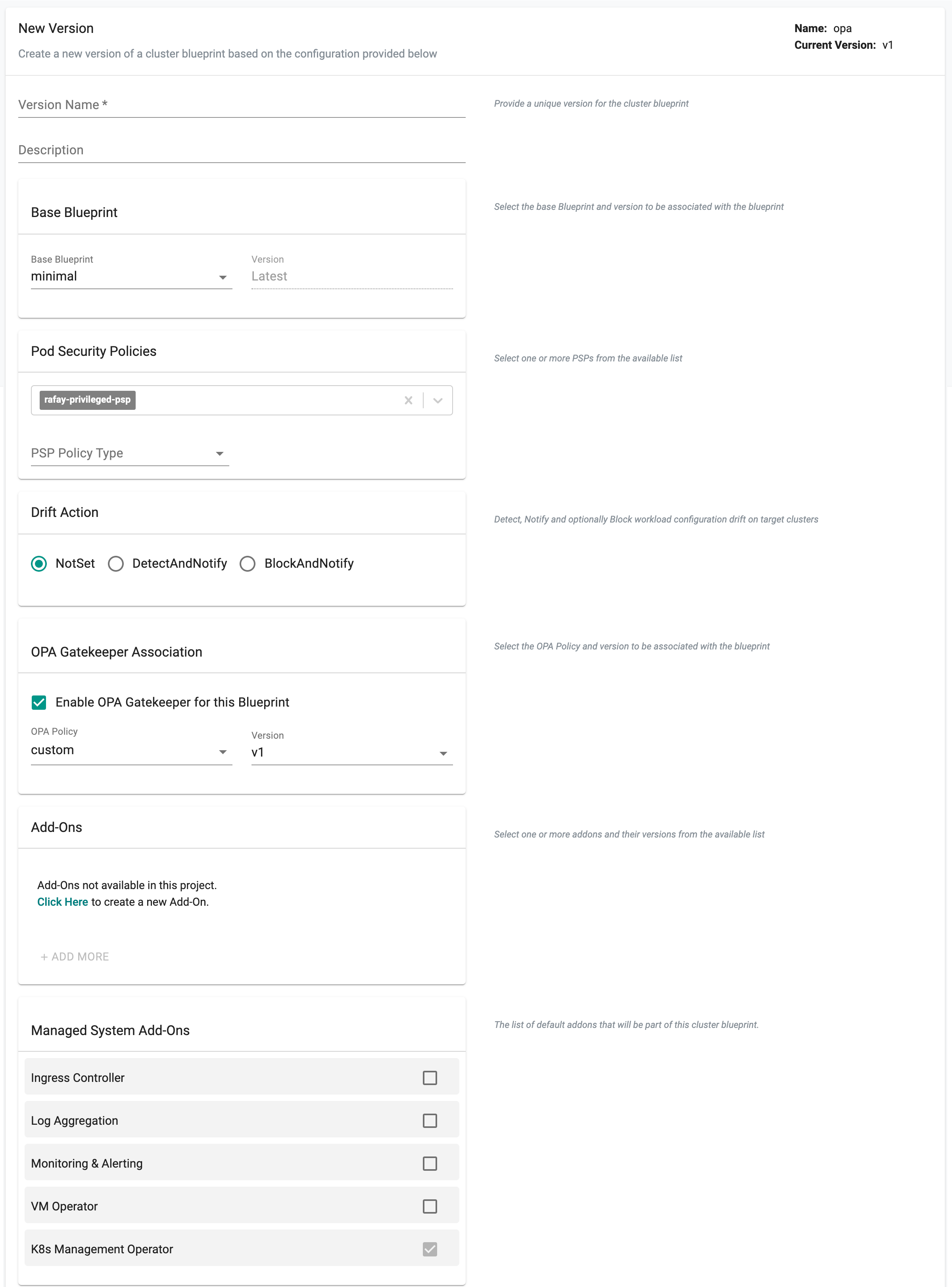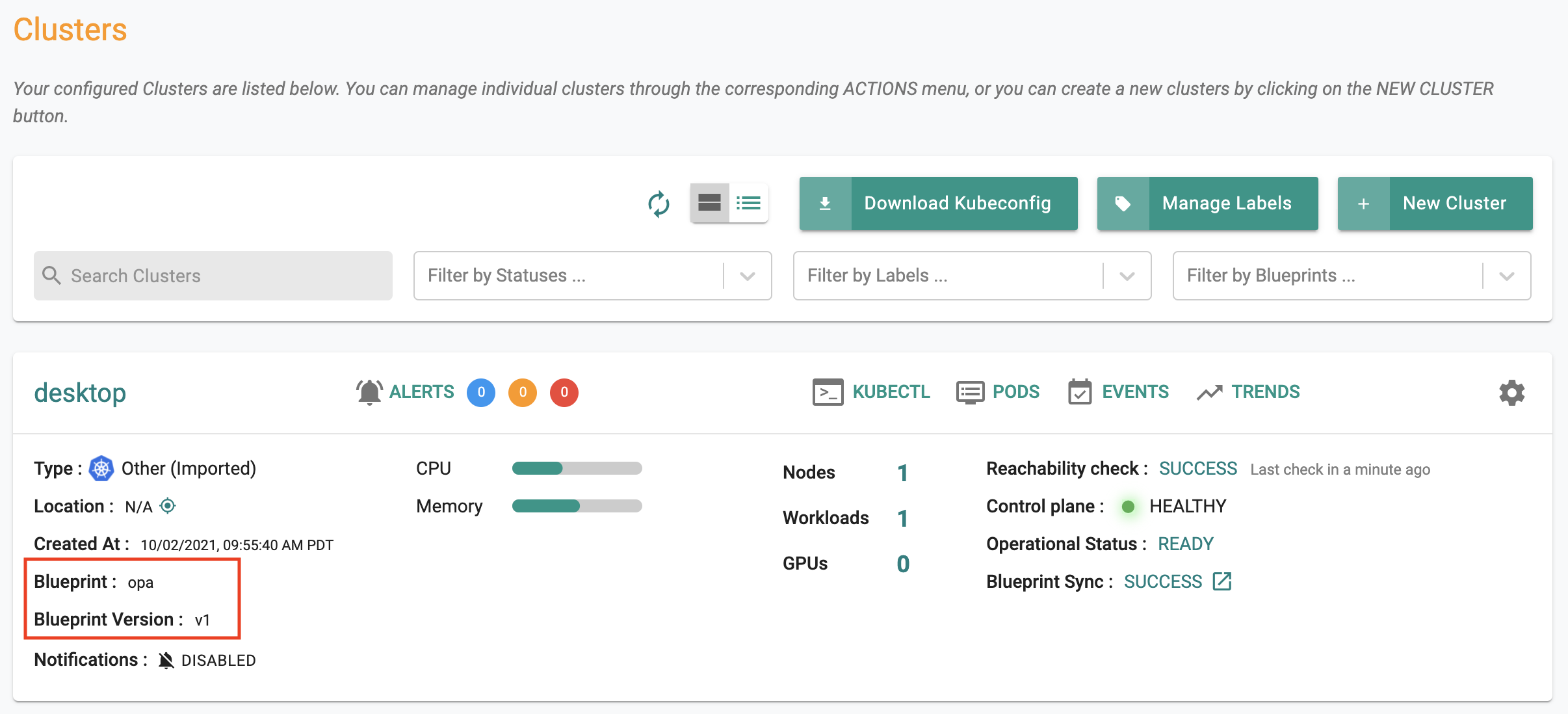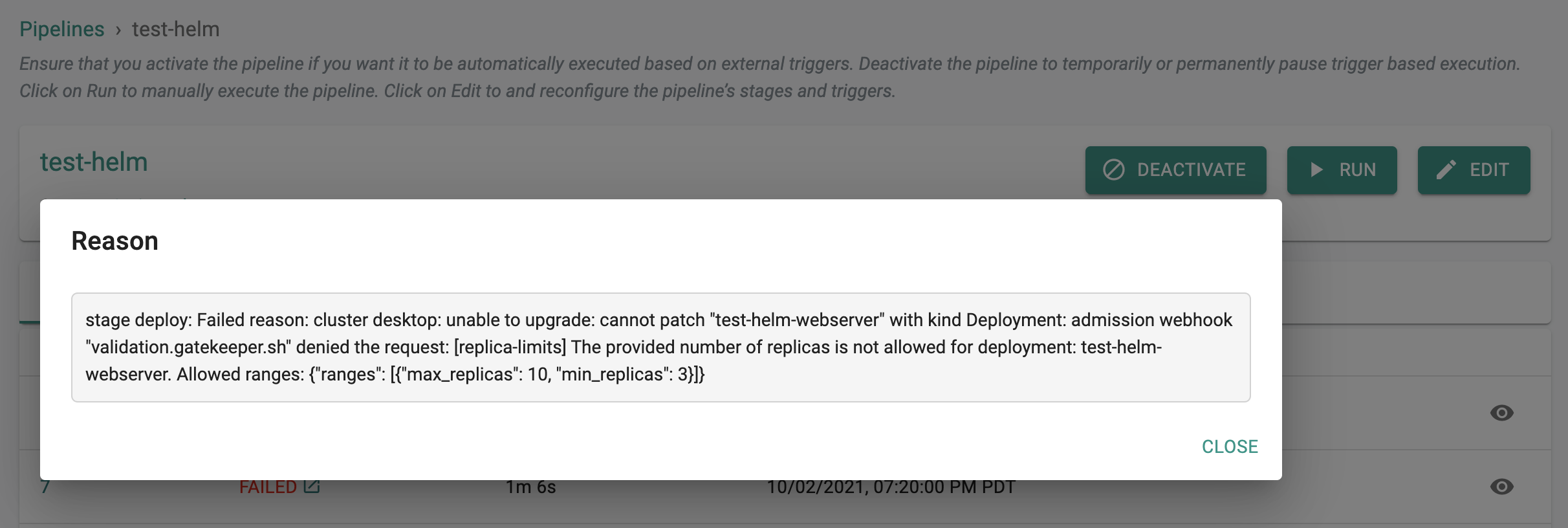Part 8: Policy Management
This is Part 8 of a multi-part, self-paced exercise.
What Will You Do¶
In this part, you will create an OPA gatekeeper policy in your project and enforce it on a cluster in your project. You will deploy a workload out of compliance with the policy and notice that it is blocked from deployment to the cluster.
Estimated Time
Estimated time burden for this part is 15 minutes.
Step 1: Setup Workload¶
One of the key benefits of using OPA Gatekeeper for policy management is that in addition to enforcing policies during "admission" to the Kubernetes cluster, it can also be used to determine which k8s resources "already existing" on the cluster are "out of compliance" with policy.
In this step, we will ensure we deploy a workload from Part-7 with a specific number of replicas that will be out of compliance with our policy. We will use this to show how you can identify resources in violation of policy.
- Ensure that the "replicaCount" in the values.yaml file is set to "2"
# Default values for webserver.
# This is a YAML-formatted file.
# Declare variables to be passed into your templates.
replicaCount: 2
nginx:
name: frontend
image:
On your cluster, when you kubectl in the workload's namespace, you should see something like the following.
kubectl get po -n first
NAME READY STATUS RESTARTS AGE
test-helm-webserver-77585694cc-29vtc 2/2 Running 11 10s
test-helm-webserver-77585694cc-qkvjd 2/2 Running 11 10s
Step 2: Constraint Template¶
You can have as many policies as you want in a Project in an Org. An OPA policy comprises one or many OPA Gatekeeper constraints. In this step, we will create a custom constrain template which will require all "k8s deployments" deployed on the cluster to have a "Replica Count" within the "specified limit".
Constraint Template
- Save the YAML File on your laptop
- In your project, navigate to OPA Gatekeeper -> Constraint Templates
- Althought a number of templates are provided out of the box, we want to create a custom template
- Click on new template
- Enter "k8sreplicalimits" and select "upload file" for artifact sync
- Upload the YAML file you saved above
Important
Ensure that the name you provide for the template matches the name in the YAML file
apiVersion: templates.gatekeeper.sh/v1beta1
kind: ConstraintTemplate
metadata:
name: k8sreplicalimits
annotations:
description: Requires a number of replicas to be set for a deployment between a min and max value.
spec:
crd:
spec:
names:
kind: k8sreplicalimits
validation:
# Schema for the `parameters` field
openAPIV3Schema:
type: object
properties:
ranges:
type: array
items:
type: object
properties:
min_replicas:
type: integer
max_replicas:
type: integer
targets:
- target: admission.k8s.gatekeeper.sh
rego: |
package k8sreplicalimits
deployment_name = input.review.object.metadata.name
violation[{"msg": msg}] {
spec := input.review.object.spec
not input_replica_limit(spec)
msg := sprintf("The provided number of replicas is not allowed for deployment: %v. Allowed ranges: %v", [deployment_name, input.parameters])
}
input_replica_limit(spec) {
provided := input.review.object.spec.replicas
count(input.parameters.ranges) > 0
range := input.parameters.ranges[_]
value_within_range(range, provided)
}
value_within_range(range, value) {
range.min_replicas <= value
range.max_replicas >= value
}
Step 3: Constraint¶
In this step, we will create a "custom constraint" based on the "constraint template" from the previous step. This constraint allows you to "define/specify" a MIN and MAX replicas for all deployments on your cluster.
- Download the YAML File to your laptop
- Navigate to OPA Gatekeeper -> Constraints
- Click on new constraint
- Enter "replica-limits" and select the constraint template configured as part of the previous step from the dropdown
- Provide a version name, select "upload file" for artifact sync
- Upload the YAML file you saved above
Important
Ensure that the name you provide for the constraint matches the name in the YAML file
apiVersion: constraints.gatekeeper.sh/v1beta1
kind: k8sreplicalimits
metadata:
name: replica-limits
spec:
match:
kinds:
- apiGroups: ["apps"]
kinds: ["Deployment"]
parameters:
ranges:
- min_replicas: 3
max_replicas: 10
Step 4: Policy¶
A policy comprises at least one constraints (default and/or custom) and optional exclusions.
- Navigate to OPA Gatekeeper -> Policy
- Click on new Policy, provide a name and Save
- Provide a version (alphanumeric is ok)
- Select the "replica-limits" constraint from the dropdown and Save
Step 5: Cluster Blueprint¶
In the previous step, you created a policy comprising OPA Gatekeeper constraints. Now, you will include this policy in a "custom cluster blueprint" and apply it to your cluster. This step will be very similar to what you did in Part 5.
Important
You can use the same cluster blueprint for multiple clusters achieving project and org wide standardization and compliance.
- Navigate to Infrastructure -> Blueprints
- Create a new blueprint and provide a name (e.g. opa)
- Click on new version
- Select "minimal" for base blueprint
- Select "Enable OPA Gatekeeper", select the "OPA policy" and version we created in the previous step and Sav
Navigate to your cluster and apply the "OPA" custom cluster blueprint on the cluster. In a few minutes, all required components for OPA Gatekeeper and the constraints will become operational on your cluster.
Optionally, you can also use kubectl to look at the OPA gatekeeper resources on the cluster
kubectl get po -n rafay-system
NAME READY STATUS RESTARTS AGE
controller-manager-868759489b-f6xpg 1/1 Running 30 35h
edge-client-75d456497-78tqp 1/1 Running 1 35h
gatekeeper-audit-69d75d695c-rwnnd 1/1 Running 0 28h
gatekeeper-controller-manager-59fb975495-rvnks 1/1 Running 0 25s
gatekeeper-controller-manager-59fb975495-x2fpw 1/1 Running 0 25s
gatekeeper-controller-manager-59fb975495-zj5dg 1/1 Running 0 25s
rafay-connector-6c6c4f67cf-m5c6n 1/1 Running 44 35h
relay-agent-7bb69f58c4-5chgc 1/1 Running 1 35h
velero-dk6wpm1-desktop-55f57589ff-x6nf8 1/1 Running 0 23h
To check if the OPA gatekeeper "constraints" we specified in the policy are operational on the cluster. As you can see from the results, OPA Gatekeeper was automatically deployed to the cluster with configuration from the policy we specified.
kubectl get constraints
NAME AGE
replica-limits 5m
Step 6: Policy Violations¶
- Navigate to Project -> OPA Gatekeeper -> Policy Violations
- The Cluster tab shows the list of violations in the cluster and the number of policy violations on each cluster
In our example, we can see that it is reporting that our pre-existing workload has deployments that violate our policy.
Step 7: New Deployments¶
In this step, we will see what workload owners will experience if they try to deploy a new workload or update an existing workload that is not in compliance with the configured policy in the cluster blueprint.
- Navigate to your Git repo and update the "replicaCount" in the values.yaml file to "1"
- The GitOps pipeline will pick up the changes and attempt to deploy to the remote cluster
- The pipeline job will fail because the specs are "not in compliance" with the configured policy. Workload owners will be presented with a friendly error message as in the example shown below.
Recap¶
Congratulations! At this point, you have successfully created a policy and tested enforcement on your Kubernetes cluster.






